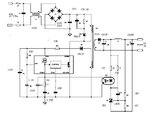neazoi
Advanced Member level 6
Hello I am building a microcontroller project using an ATMega644. Acording to the datasheet this draws less than 1mA at 1MHz, although I run it at 20MHZ in my project.
I need to make a transformerless PSU for this project and I have found two schematics.
https://www.learningelectronics.net/circuits/transformerless-5-volt-power-supply.html
https://www.learningelectronics.net/circuits/low-power-12v-transformerless-power.html
One of these is much more simple, so I turn towards this one. I also like this simpler one because "the zero voltage reference of the DC voltage is not directly connected to the neutral line of the 230-V circuit". I do not know what it means but it seems more safe.
I would like to know If I can additionally connect a 250VAC varistor and a fuse at the input, like shown in the attached schematic?
I need to make a transformerless PSU for this project and I have found two schematics.
https://www.learningelectronics.net/circuits/transformerless-5-volt-power-supply.html
https://www.learningelectronics.net/circuits/low-power-12v-transformerless-power.html
One of these is much more simple, so I turn towards this one. I also like this simpler one because "the zero voltage reference of the DC voltage is not directly connected to the neutral line of the 230-V circuit". I do not know what it means but it seems more safe.
I would like to know If I can additionally connect a 250VAC varistor and a fuse at the input, like shown in the attached schematic?
Attachments
Last edited:

